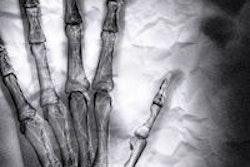VIENNA - As MRI continues to advance to greater magnet strengths to uncover mysteries in the body, researchers of a new study are warning that constant exposure to high-field systems could lead to psychological problems, such as clinical depression, among MRI radiographers.
During Monday's final day of activity at ECR 2013, researchers from Saudi Arabia found a clinical depression rate of 25% in one region of the country among MRI radiographers, or technologists, with more than five years of working with high-field magnets.
"MRI technologists are working every day, going inside and outside the scanning room from low-field to high-field magnetic fields," said lead study author Nabeeb Mishah, an MRI radiographer and educator at King Abdulaziz University Hospital in Jeddah. "This is chronic exposure, which may carry psychological side effects on the MRI technologist, since the high magnetic field potentially may carry an occupational hazard on the central nervous system and brain chemicals, leading to other disorders, such as depression."
Mishah and colleagues distributed questionnaires to 100 MRI radiographers practicing in public and private hospitals in three major cities in the Makkah region of southwest Saudi Arabia. Forty-five surveys were returned, with five responses excluded for lack of information or limited MRI experience.
BDI evaluation
The questions and data in the study were based on the Beck Depression Inventory (BDI), which, according to Mishah, is considered worldwide as the most reliable method to screen and evaluate for clinical depression.
In the BDI are two main components of clinical depression, Mishah explained. There are affected mood swings, which include suicidal thoughts and agitation, as well as physical or somatic elements, which include 13 variables, such as loss of appetite. MRI radiographers responded to the BDI queries and provided family and personal histories regarding previous evidence of clinical depression.
The 40 acceptable respondents included 26 men and 14 women. More than half of the MRI radiographers in the study had more than five years of experience. A clinical psychologist then reviewed the replies.
Based on the questionnaire results, the researchers found that 35% of the respondents said they had lost interest in a hobby and 35% noted they were easily agitated. Having a sleeping disorder was listed by 30% of those polled, 25% wrote they felt guilty or worthless, and 30% suffered from loss of concentration. Being constantly tired or fatigued was checked by 32% of the MRI radiographers.
Suicidal thoughts
After clinical psychologist evaluated the questionnaires, "we found that 10 technologists of those 40 surveyed have depression, which is 25% of our population in this study," Mishah said in his ECR presentation.
To see how that number compares with other healthcare professionals, Mishah and colleagues compared their results to dentists in the U.S. According to a 2005 study in the Journal of the American Dental Association, U.S. dentists have a clinical depression rate of 10% (JADA, October 2005, Vol. 136:10, pp. 1388-1395).
Researchers also noted that the clinical depression rate among the general Saudi population is 6.5%, according a study from the Saudi Psychiatry Association. That study also used the BDI questionnaire as its psychological barometer, Mishah noted.
Perhaps most disturbing is that 10% responded that they wanted to die. Mishah also noted that 13% replied that they were "following up in the psychiatric clinic."
'Strong association'
Based on the results, Mishah said there "might be a strong association" between the high rate of depression among MRI radiographers, especially for those who have worked more than five years.
"Our recommendation is to perform further studies in this field and to increase the sample size by including other MRI technologists from different countries," he added.
Mishah also suggested that the current MRI radiographers-to-scanner ratio of 1-to-1 be increased to two technologists per high-field MRI system, "so we can decrease chronic exposure to this magnetic field by 50%."











